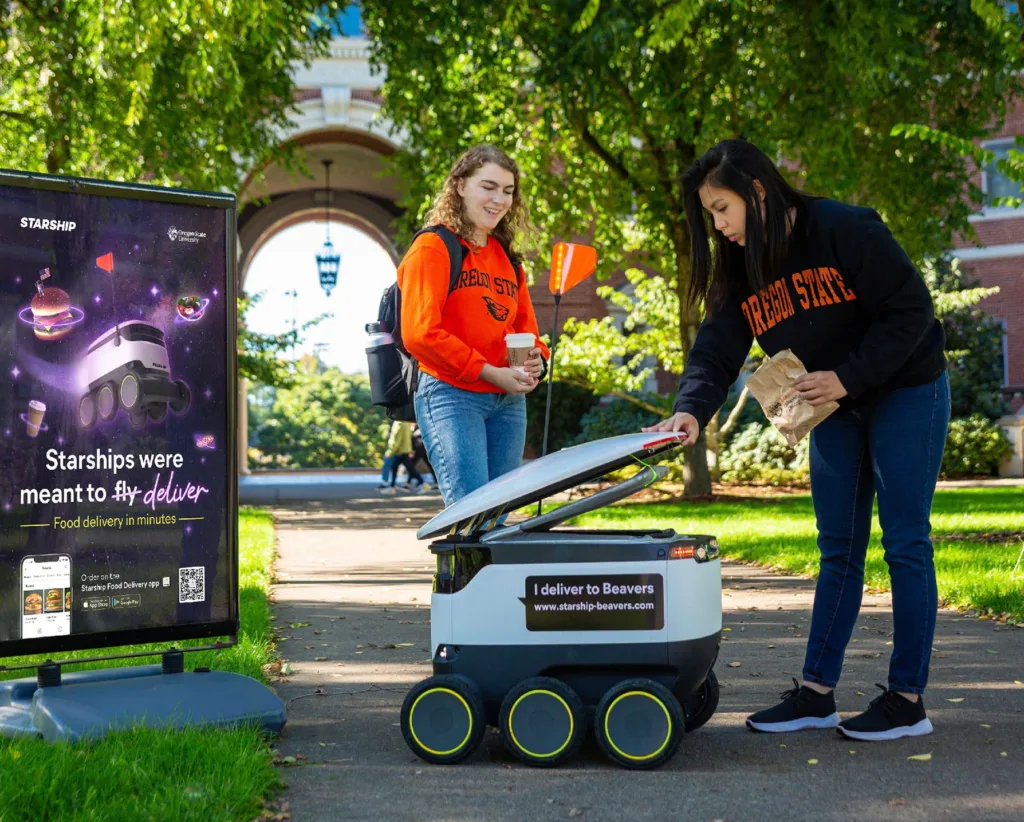Table of Contents
Uber Eats robot delivery project marks one of the most important moves in years. Uber Eats confirmed that it will work with Starship Technologies to begin robot delivery in the United Kingdom later this year. This agreement places the company among the leaders in automated home delivery and signals the start of a new strategy for long term service expansion in Europe and the United States.
Why the Uber Eats robot delivery launch matters
Uber Eats said that the Uber Eats robot delivery system will begin in December, starting with select merchants in Leeds and Sheffield. The company plans to expand the program to additional European countries in 2026 and then bring the same approach to the United States in 2027. This step shows how fast the delivery industry is shifting as major companies test automation to improve speed, reach new areas, and reduce manual strain on human couriers.
The primary goal is simple. Uber Eats wants technology that helps complete more orders with lower wait times. The company believes that the Uber Eats robot delivery network can solve congestion issues, reduce delays, and help restaurants reach customers in areas where human couriers face slower travel times.
How the Uber Eats robot delivery system works with Starship

Starship Technologies has spent years building a large fleet of small, six wheeled robots that travel on sidewalks. The company has almost three thousand robots in service across more than two hundred seventy global locations. These robots are already active in university campuses, residential neighborhoods, and city districts. They usually complete trips in under thirty minutes and they travel no more than two miles at a time.
This experience makes Starship the strongest partner for the new Uber Eats robot delivery rollout. Instead of building robots on its own, Uber Eats will place its software inside Starship robots. That means customers will place orders inside the Uber Eats app, select the robot delivery option, and then watch a live map as the robot begins its trip. The robot will stop at the restaurant, pick up the order, close the secure lid, and travel to the customer location. The customer will unlock the robot with a phone code and collect the meal.
The Uber Eats robot delivery experience will feel like a normal delivery from the user perspective, but the process inside the city will change. Starship robots move at low speeds and avoid roads. They use camera systems, sensors, and real time routing to move around obstacles. Each robot sends live data to a Starship operations center where staff monitor technology and handle alerts.
Uber Eats said that robot delivery helps reduce late orders during busy hours. Restaurants often face spikes during lunch and dinner. Human couriers can only complete a certain number of trips before traffic slows them down. Robots help fill the gaps in short range delivery zones so human couriers can focus on longer trips.
The Leeds and Sheffield launch will begin with select restaurants, but Uber Eats plans to expand the list based on performance. SquaredTech expects user demand to grow quickly because these cities have many short range routes that fit the ideal distance for Starship robots.
Why Uber Eats robot delivery is part of a bigger plan
Uber Eats has worked with many autonomous vehicle partners before the Starship agreement. The company used Serve Robotics units in parts of the United States. It also tested sidewalk robots from Avride earlier this year. These trials helped Uber Eats study how automation performs in real neighborhoods.
However, Uber Eats chose Starship for this new stage because Starship has the largest active fleet in the delivery robot sector. A bigger fleet means more reliable operations, faster response times, and smoother scaling across new cities. SquaredTech views this as a clear signal that Uber Eats wants long term stability for its robot delivery program.
Starship builds its robots to handle daily travel through crowded areas. The robots can move on sidewalks filled with pedestrians, street signs, bikes, and pets. They can also handle light rain, low light conditions, and mild hills. These strengths make the robots suitable for British cities where weather shifts often and foot traffic varies by district.
The Uber Eats robot delivery partnership also shows how companies are responding to high delivery demand in dense areas. Food delivery volume keeps rising each year. Human couriers help cover wide regions, but robots help fill short trips that take up driver time but pay less per distance. Automation allows companies to balance costs while customer satisfaction rises.
This partnership also prepares Uber Eats for future global expansion. By confirming that the program will move into more European markets in 2026 and into the United States in 2027, the company sends a clear message. Automation will play a major part in its service plan. SquaredTech believes that this strategy will help Uber Eats compete with rivals that are building similar automated services.
What customers should expect from Uber Eats robot delivery
First, customers will place an order and select robot delivery if available. The app will show an estimated arrival time. Uber Eats says most Starship deliveries finish in less than thirty minutes. That means urban customers may receive meals faster than traditional courier trips, especially during peak hours.
Second, customers will track the robot as it moves across the map. The app will show its movement step by step as it travels along approved sidewalks. Starship robots follow safe routes and avoid areas that create delays.
Third, customers will receive a message when the robot arrives. They will unlock the lid using a phone code. This prevents anyone else from opening the robot.
Fourth, the robot will return to the base station or move to the next order. This continuous cycle helps the fleet operate at high efficiency.
Our team notes that this system may not suit every location. Some neighborhoods may lack smooth sidewalks or may have narrow sections that slow the robot. These areas may receive robot delivery later after initial tests. Still, most of Leeds and Sheffield have suitable paths for the launch.
Why this launch matters for the future of delivery
The Uber Eats robot delivery program highlights a major trend across the delivery market. Companies want to shorten delivery times, reduce fuel use, and increase output. They also want safe tools that reduce pressure on human couriers. Robots help accomplish these goals without requiring complex road testing or heavy regulation because sidewalk robots follow different rules from self driving cars.
Starship says its robots create lower noise and produce lower emissions than cars or scooters. This factor may help cities support wider robot deployment in the future. If robots reduce traffic pressure in busy food delivery districts, more cities may invite partnerships with major companies.
Uber Eats robot delivery may also lead to new job roles. Human couriers may shift to longer routes while operations staff monitor robot networks. Restaurants may also receive more orders during peak periods because robots can handle more short trips.
We believe this shift will accelerate across Europe after the first year of successful service in the UK. The planned expansion into 2026 shows that Uber Eats views this as a long term technology change rather than a small experiment.
Final Thoughts
The Uber Eats robot delivery partnership with Starship marks a major step forward for automated food delivery. The program launches in the UK with clear plans for expansion. Starship brings a large fleet with strong performance, and Uber Eats brings a global network that can scale fast.
SquaredTech will continue monitoring how users respond, how cities adapt, and how the technology develops in future European and American markets. The success of this partnership will shape how fast delivery companies adopt automation worldwide.
Stay Updated: Tech News – Emerging technologies


